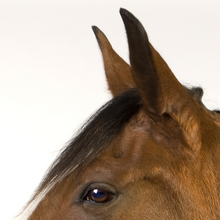The latest findings of scientists at the University of Sussex show horses single out humans through using a "cross modal" ability. The same researchers previously determined that the horses also recognize members of their herd in this way.

Use of auditory and visual clues by horses
Horses are able to match a familiar voice to a familiar person.
When humans hear a familiar voice they form a mental picture of who spoke by matching visual and auditory cues. This 'crossmodal' perception involving interactions between two or more different senses was once believed to have been a purely human trait.
In the first experiment involving 32 horses, subjects turned to look more quickly, for longer and more often at their owner when they heard their voice over a loudspeaker than when they heard a stranger's.
Animal psychologist Dr Leanne Proops said: "Subjects were able to match a familiar voice to a familiar person but did not match an unfamiliar voice to an unfamiliar person.
"The matching of the owner to their voice does not reflect a spontaneous preference for looking towards the owner, instead subjects actively associate the audio and visual stimuli.
"Whether the failure to match the stranger to the unknown voice reflects an inability to infer that an unknown voice comes from an unknown individual or they are not motivated to respond to a stranger calling their name is unclear."
In a second experiment, involving 40 horses, subjects proved able to match a specific voice to a familiar human handler.
Dr Proops said: "This indicates the sight of the handler activated a multi-modal memory of that specific individual, allowing subjects to match the sight of that particular person with the sound of their voice."
She said it also suggests horses use this recognition strategy naturally to identify numerous individual people in their day-to-day lives.
Study co-author Dr Karen McComb said: "The ability to match the sight of familiar individuals with their voice, without explicit training, has also since been demonstrated in non-human primates and crows."
She said the skill to distinguish people may have evolved among horses to help them know exactly who they can trust.
Dr McComb said: "Horses are a species that have a lot of interactions with humans, like domestic dogs."
Results of the study also suggest the left-side of the brain predominates in this skill, because the horses were much better at performing the task when the person was standing on their right.
Dr Proops added: "These results are the first to demonstrate cross-modal recognition in animals can extend to individuals from very distant species.
"They also indicate processes governed by the left hemisphere are central to the cross-modal matching of visual and auditory information from familiar individuals in a naturalistic setting."
The research was published in the Proceedings of the Royal Society B.
